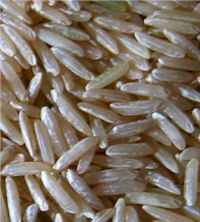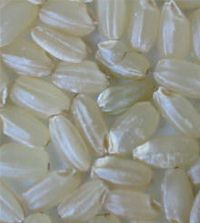Rice, or Ryse, the grain of Oryza sativa, a native cereal of India, is considered here scarcely as a Herbal Simple, but rather as a common article of some medicinal resource in the store cupboard of every English house-hold, and therefore always at band as a vegetable remedy.
Among the Arabs Rice is considered a sacred food: and their tradition runs that it first sprang from a drop of Mahomet's perspiration in Paradise.
Being composed almost exclusively of starch, and poorer in nitrogen, as well as in phosphoric acid, than other cereals, it is less laxative, and is of value as a demulcent to palliate irritative diarrhea, and to allay intestinal distress.
A mucilage of Rice made by boiling the well-washed grain for some time in water, and straining, contains starch and phosphate of lime in solution, and is therefore a serviceable emollient. But when needed for food the grain should be steamed, because in boiling it loses the little nitrogen, and the greater part of the lime phosphate which it has scantily contained.
Rice bread and Rice cakes, simply made, are very light and easy of digestion. The gluten confers the property of rising on dough or paste made of Rice flour. But as an article of sustenance Rice is not well suited for persons of fermentative tendencies during the digestion of their food, because its starch is liable to undergo this chemical change in the stomach.
Dr. Tytler reported in the "Lancet" (1833), cases resembling malignant cholera from what he termed the morbus oryzoeus, as provoked by the free and continued use of Rice as food. And Boutins, in 1769, published an account of the diseases common to the East Indies, in which he stated that when Rice is eaten more or less exclusively, the vision becomes impaired. But neither of these allegations seems to have been afterwards authoritatively confirmed.
Chemically, Rice consists of starch, fat, fibrin, mineral matter such as phosphate of lime, cellulose, and water.
A spirituous liquor is made in China from the grain of Rice, and bears the name "arrack."
Rice cannot be properly substituted in place of succulent green vegetables dietetically for any length of time, or it would induce scurvy. The Indians take stewed Rice to cure dysentery, and a decoction of the grain for the purpose of subduing inflammatory disorders.
Paddy, or Paddee, is Rice from which the husk has not been removed before crushing. It has been said by some that the cultivation of Rice lowers vitality, and shortens life.
In Java a special Rice-pudding is made by first putting some raw Rice in a conical earthen pot wide at the top, and perforated in its body with holes. This is placed inside another earthen pot of a similar shape but not perforated, and containing boiling water. The swollen Rice soon stops up the holes of the inner pot, and the Rice within becomes of a firm consistence, like pudding, and is eaten with butter, sugar, and spices.
An ordinary Rice-pudding is much improved by adding some rosewater to it before it is baked.
This grain has been long considered of a pectoral nature, and useful for persons troubled with lung disease, and spitting of blood, as in pulmonary consumption. The custom of throwing a shower of Rice after and over a newly married couple is very old, though wheat was at first the chosen grain as an augury of plenty. The bride wore a garland of ears of corn in the time of Henry the Eighth.
Herb Simples
The Primitive Simplers presented here show the way of life in other generations, it is not suggested or recommended trying them yourself. |
|
Garden
Herbs
Home
History of Herbs
Herb Gardening
Herbs for Beginners
Drying & Preserving Herbs
Indoor Herb Gardening
Herb Garden
Hints & Tips
Herbal
Cooking
Herb Chart
Using Herbs
Culinary Herbs
Herb
Oil and Vinegar
Herb Teas
Herb Candy
Herb Jelly
Herb Simples
Preface
Introduction
Alphabetical Listing

Trade
Recipes Online
Share your Recipes with others!!
|




